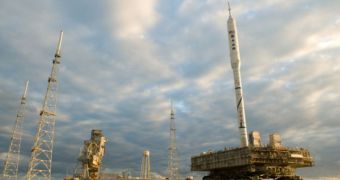With the prototype ARES I-X rocket poised to launch next week, NASA is entering a crucial step in its test phase of the new ARES I delivery system, which is scheduled to lift the Orion Crew Exploration Vehicle – the shuttle replacement – into the low-Earth orbit in 2015. A successful test on October 27 would help the space agency gain more support in its quest for funding on Project Constellation, which has been severely bashed by the new panel review of the space agency and its plans.
An independent, blue-ribbon commission was appointed by US President Barack Obama earlier this year to assess the situation at NASA, and to provide guidelines and proposals related to the future of US space exploration. In a final version of the 156-page document, the panel recommended that the space agency should let the private sector take some of the load off its shoulders, and run missions to the International Space Station (ISS).
The report turned many people away from Project Constellation, and NASA cannot afford this to happen. In order to respect its 2015 deadline for ARES I and Orion, it needs an additional $3 billion by 2014, on top of the current budget predictions. George Washington University space policy expert and Professor Emeritus John Logsdon summed it up best a couple of days ago – “Ares I is living on a very thin thread.” In their report, panel members wrote, “The committee found that, because of technical and budget issues, the Ares I schedule no longer supports ISS needs.”
According to Logsdon, the main idea behind this sentence is that flying ARES I may be just a waste. “You might spend multiple billions of dollars to build a rocket that you're not going to use very often,” he explained. On this note, a successful test on Tuesday would show a lot of people that the new rocket is still a viable option, and would also gain NASA some supporters in appropriations committees. It desperately needs that at this point. Otherwise, the $9 billion it spent on the Project over the past four years would have been in vain.
“Everybody is very excited. We've been working hard to get to this point,” the Ares I-X Deputy Mission Manager, Jon Cowart, said of the $445-million test fligh. “Clearly this flight would be of higher value if the Ares I program is going to proceed,” Logsdon added, quoted by Space.

 14 DAY TRIAL //
14 DAY TRIAL //